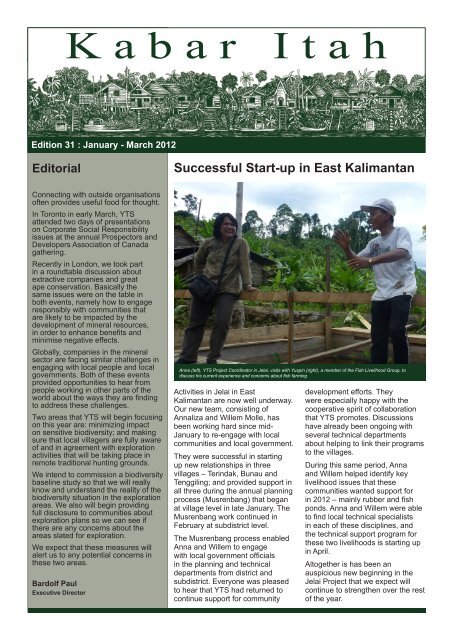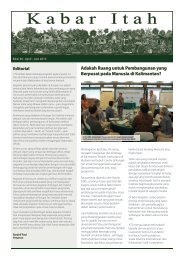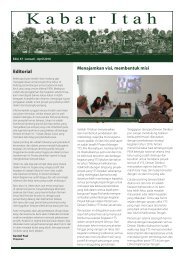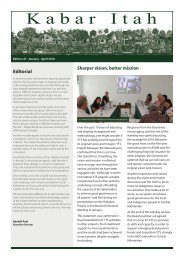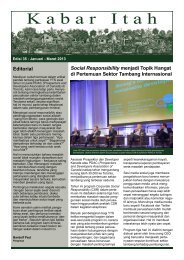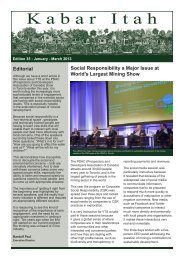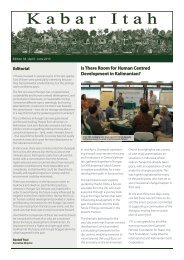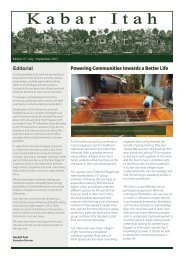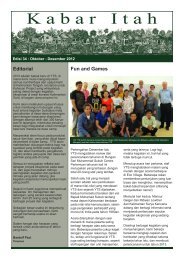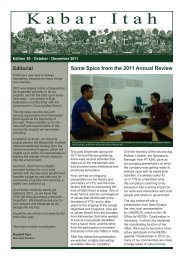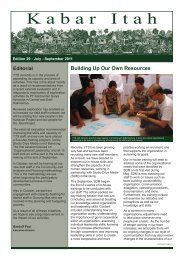Kabar Itah 2012-31(E)
Kabar Itah 2012-31(E)
Kabar Itah 2012-31(E)
Create successful ePaper yourself
Turn your PDF publications into a flip-book with our unique Google optimized e-Paper software.
K a b a r I t a h<br />
Edition <strong>31</strong> : January - March <strong>2012</strong><br />
Editorial<br />
Successful Start-up in East Kalimantan<br />
Connecting with outside organisations<br />
often provides useful food for thought.<br />
In Toronto in early March, YTS<br />
attended two days of presentations<br />
on Corporate Social Responsibility<br />
issues at the annual Prospectors and<br />
Developers Association of Canada<br />
gathering.<br />
Recently in London, we took part<br />
in a roundtable discussion about<br />
extractive companies and great<br />
ape conservation. Basically the<br />
same issues were on the table in<br />
both events, namely how to engage<br />
responsibly with communities that<br />
are likely to be impacted by the<br />
development of mineral resources,<br />
in order to enhance benefits and<br />
minimise negative effects.<br />
Globally, companies in the mineral<br />
sector are facing similar challenges in<br />
engaging with local people and local<br />
governments. Both of these events<br />
provided opportunities to hear from<br />
people working in other parts of the<br />
world about the ways they are finding<br />
to address these challenges.<br />
Two areas that YTS will begin focusing<br />
on this year are: minimizing impact<br />
on sensitive biodiversity; and making<br />
sure that local villagers are fully aware<br />
of and in agreement with exploration<br />
activities that will be taking place in<br />
remote traditional hunting grounds.<br />
We intend to commission a biodiversity<br />
baseline study so that we will really<br />
know and understand the reality of the<br />
biodiversity situation in the exploration<br />
areas. We also will begin providing<br />
full disclosure to communities about<br />
exploration plans so we can see if<br />
there are any concerns about the<br />
areas slated for exploration.<br />
We expect that these measures will<br />
alert us to any potential concerns in<br />
these two areas.<br />
Bardolf Paul<br />
Executive Director<br />
Anna (left), YTS Project Coordinator in Jelai, visits with Yuspin (right), a member of the Fish Livelihood Group, to<br />
discuss his current experience and concerns about fish farming<br />
Activities in Jelai in East<br />
Kalimantan are now well underway.<br />
Our new team, consisting of<br />
Annaliza and Willem Molle, has<br />
been working hard since mid-<br />
January to re-engage with local<br />
communities and local government.<br />
They were successful in starting<br />
up new relationships in three<br />
villages – Terindak, Bunau and<br />
Tenggiling; and provided support in<br />
all three during the annual planning<br />
process (Musrenbang) that began<br />
at village level in late January. The<br />
Musrenbang work continued in<br />
February at subdistrict level.<br />
The Musrenbang process enabled<br />
Anna and Willem to engage<br />
with local government officials<br />
in the planning and technical<br />
departments from district and<br />
subdistrict. Everyone was pleased<br />
to hear that YTS had returned to<br />
continue support for community<br />
development efforts. They<br />
were especially happy with the<br />
cooperative spirit of collaboration<br />
that YTS promotes. Discussions<br />
have already been ongoing with<br />
several technical departments<br />
about helping to link their programs<br />
to the villages.<br />
During this same period, Anna<br />
and Willem helped identify key<br />
livelihood issues that these<br />
communities wanted support for<br />
in <strong>2012</strong> – mainly rubber and fish<br />
ponds. Anna and Willem were able<br />
to find local technical specialists<br />
in each of these disciplines, and<br />
the technical support program for<br />
these two livelihoods is starting up<br />
in April.<br />
Altogether is has been an<br />
auspicious new beginning in the<br />
Jelai Project that we expect will<br />
continue to strengthen over the rest<br />
of the year.
Subdistrict Musrenbang in Kahayan<br />
This year government officials became more actively involved in annual musrenbang planning in Damang Batu Subdistrict in<br />
Kahayan Project<br />
Progress of the <strong>2012</strong> Subdistrict Musrenbang annual<br />
planning in the Kahayan has been encouraging, proof of<br />
the success of YTS’s approach in Central Kalimantan. The<br />
new Governance Strengthening Program, started January,<br />
has greatly influenced the Musrenbang and has brought<br />
significant progress to the overall community development<br />
program. Indeed, as the governance support program aims<br />
at strengthening the government’s capacities, increased<br />
participation of the latter in enhancing local development<br />
has aroused the curiosity and interest of local communities<br />
in the Musrenbang and consequently, it has also increased<br />
the number of participants. Such a positive outcome<br />
illustrates how bridging the communication gap between<br />
the government and local communities benefits local<br />
development.<br />
The governmental measure that most attracted local<br />
community members to the Musrenbang this year is the<br />
brand new Indicative Budget Ceiling Method: The method<br />
is a breakthrough created this year<br />
by the Gunung Mas government in<br />
order to improve the process and<br />
outcomes of annual development<br />
planning. The indicative budget<br />
ceiling presents clearly the budget<br />
the government can allocate<br />
for development at village level.<br />
Thanks to this, communities are<br />
now better able to adjust their<br />
requests to the government<br />
and improve their prioritization<br />
process. Indeed, before the<br />
Indicative Budget Ceiling Method<br />
was implemented, communities<br />
would submit a lengthy list of<br />
development proposals and<br />
rarely obtain satisfaction from the<br />
government, as the requests would<br />
not match the budget allocations.<br />
This new process avoids confusion<br />
and optimizes the communities’<br />
chances to obtain government<br />
support for local development. By<br />
promoting this strategy, the government is also hoping<br />
to harmonise development programs and activities<br />
in each village. So far, the method was successfully<br />
applied in the Musrenbang in two subdistricts,<br />
Damang Batu and Kahayan Hulu Utara, and it<br />
has enabled each government agency and village<br />
delegation to agree on development priorities. It is<br />
expected that it will also be extended to Miri Manasa<br />
subdistrict before the end of 2013.<br />
Overall, YTS has witnessed great progress in the<br />
Musrenbang this year, mainly related to the increase<br />
of the local government participation in the process<br />
and to the increase of communication between local<br />
communities and local government. However, the next<br />
point that YTS will be working on is to ensure that<br />
increased government participation in the Musrenbang<br />
does not alter the community members’ internal<br />
decision-making potential.<br />
“This year the musrenbang process is better than before.<br />
I feel that the process was properly prepared, and for me<br />
personally this is a historical moment as I had the chance<br />
to see the representatives from hamlet I and hamlet II<br />
come together to attend the meeting, almost with the same<br />
number of people. Previously, the villagers from hamlet II,<br />
the original villagers of Mangkuhung, tended to refuse to<br />
blend with villagers from the other hamlet and outsiders.<br />
Thanks to the approach from YTS facilitators, who made<br />
it possible. Looking at the implementation process,<br />
musrenbang this year ran smoothly and in good order,<br />
right until the decision making process.<br />
Surya Bestary, Head of VMG, Mangkuhung-Miri Manasa<br />
”<br />
2<br />
<strong>Kabar</strong> <strong>Itah</strong> - Edition <strong>31</strong>
Mercury Prevention: the Best Cure<br />
‘Growing-Up Healthy’ is the slogan for our new media<br />
campaign: bringing new awareness to communities<br />
threatened by mercury pollution. This year, we have<br />
created materials that are designed specifically to inform<br />
women and children about the threat of mercury, as they<br />
are more likely to experience the health impacts than men.<br />
We are now starting our media campaign across Central<br />
Kalimantan, targeting mercury users<br />
in particular, as well as the wider<br />
community. In fact, our media is<br />
designed to be taken across Indonesia,<br />
and can be used equally well in Sulawesi,<br />
Java, or Lombok.<br />
Our recent health seminar, held at the<br />
UN REDD+ facility in Palangka Raya,<br />
brought together government and community<br />
– giving them new knowledge<br />
to impart to others, as well as a range<br />
of media materials. There were three<br />
presentations made: Sumali Agrawal<br />
explained our field approach; our guest<br />
speaker, Dr Rachmadhi Purwana from<br />
the University of Indonesia, gave an<br />
in-depth presentation about the health<br />
impacts of mercury; and Kartie Vitamerry<br />
explained how to deliver the media and<br />
messages to communities. As most of<br />
the participants work in the health and<br />
education sectors, we hope that they will<br />
Filming Fieldwork<br />
now be able to spread the message through schools<br />
and clinics, and other government institutions.<br />
We feel it is very important to communicate this health<br />
message as widely as possible, as methyl-mercury<br />
gradually accumulates in the environment, and many<br />
parts of Indonesia could soon be threatened by mercury-related<br />
disease, if no effort is made to prevent it.<br />
Health practitioners from various department agencies share experience and knowledge<br />
during the Health Awareness Seminar about Mercury in Palangka Raya<br />
In 2009, YTS made a film entitled “Mercury: The Burning<br />
Issue” showing how air pollution from burning gold<br />
amalgam can be prevented using simple condenser<br />
technology. The film can be downloaded free from<br />
YouTube. Soon, we hope to produce a sequel on the<br />
problem of how to prevent mercury contamination of<br />
soil and water from small scale gold mining.<br />
Rob Gould from UNEP in action, documenting gold processing activities in Mt Muro<br />
It is difficult to imagine the life of a small miner – the<br />
work is hard and brings many dangers with it, including<br />
the use of toxic chemicals. YTS is currently demonstrating<br />
mercury-free processing alternatives to miners,<br />
including the use of higher technology, such as shaking<br />
tables and centrifuges. Our hope is that these miners<br />
can go back to using water and gravity, making their<br />
environment, and ours, a much safer place.<br />
Communicating what goes on in a small upriver mining<br />
shed to the rest of the world, is made easier if the audience<br />
can visualize it clearly. For this reason, we were<br />
pleased when UNEP chose to feature our fieldwork in a<br />
short film that documents the efforts the organization is<br />
making to reduce mercury use worldwide.<br />
UNEP’s global advocacy for new policy on mercury<br />
has already brought about a ban on mercury trading in<br />
many countries. This has had the beneficial effect of<br />
driving the price up across the region, making it more<br />
difficult for wasteful practices and pollution to occur.<br />
Thus, it is the right time to demonstrate alternative<br />
processing techniques to miners, as they are also<br />
looking for ways to stop using mercury.<br />
We welcomed the opportunity to put the spotlight<br />
on our work in Central Kalimantan, as it is important<br />
for us to communicate our way of working to others.<br />
Indeed, through training, and through film and print<br />
media, we are making special efforts to educate other<br />
stakeholders how to conduct interventions, so we can<br />
all put a stop to mercury use wherever it occurs.<br />
<strong>Kabar</strong> <strong>Itah</strong> - Edition <strong>31</strong> 3
Biochar in Bukit Batu<br />
This year, YTS is bringing new agricultural<br />
methods to the attention of farmers in Bukit<br />
Batu by showing them how to make and apply<br />
two new products: Biochar and Bokashi. We<br />
began to introduce our communities to these<br />
new organic agricultural practices by holding<br />
an introductory training day at the YUM<br />
demonstration farm in Banturung.<br />
We then went on to form farmer’s interest<br />
groups in ten village locations, and to supply<br />
each of them with a stainless steel chimney.<br />
They have now just completed our initial<br />
training in making Biochar, using the chimney<br />
method. This allows three sacks of sawdust<br />
to be made into one sack of Biochar that can<br />
either be sold or used on the farm in a variety<br />
of interesting ways. Farmers are pleased that<br />
they can make a new product so easily using<br />
waste materials.<br />
All kinds of biomass can be burned, using oil<br />
drums as simple kilns, or even just by digging<br />
a pit in the earth. The secret to making Biochar<br />
lies in burning the fuel slowly. This allows the flammable<br />
gases inside the wood to escape and ignite, rather than<br />
burning the wood itself. This process is known as pyrolysis<br />
and it creates a high-quality charcoal that retains up<br />
to 70% of the carbon after burning the fuel.<br />
Mixed into the soil or sprinkled on top of the field, Biochar<br />
promotes the growth of living micro-organisms, and<br />
thus improves the cation-exchange capacity of the soil,<br />
and the plants’ ability to uptake nutrients. Biochar also<br />
improves water retention and helps to neutralize soil<br />
Capacity Building for YTS Staff<br />
Program Officers (POs) play an essential role in YTS:<br />
The quality of their assistance and support to the local<br />
communities is a guarantee of the positive impact<br />
of YTS’s projects. Regularly improving their capacity<br />
to manage and carry out development projects is a<br />
fundamental part of YTS’s commitment to the communities.<br />
YTS therefore conducted a PO Capacity Building<br />
Workshop on March 7th <strong>2012</strong> in Palangka Raya, using<br />
a participative method so all staff could share their<br />
experiences, learn from one another and develop new<br />
management skills. The main objective of the workshop<br />
was for the POs to improve their<br />
knowledge of YTS’s history, philosophy<br />
and ethics. YTS insists that all staff take<br />
a certain approach towards community<br />
development in their daily work, through<br />
open-minded management, listening<br />
and communication skills, and deep<br />
respect for local communities’ values<br />
and traditions.<br />
All YTS Program Officers participated<br />
in the workshop, through the simulation<br />
of practical situations encountered in<br />
the field. The group was successively<br />
divided into an audience and a group<br />
of actors, who then witnessed the<br />
challenges faced and took part in<br />
solving the simulated case. Participants<br />
In Banturung, a group of women belong to the Biochar Interest Group learn the simple process of making<br />
biochar to improve the quality of soil for farming purposes<br />
pH, both important attributes that can improve growing<br />
conditions in sand and peat soils.<br />
We all want to do everything we can to avoid the<br />
disastrous consequences of global climate change.<br />
Biochar provides an immense opportunity to make a<br />
difference by feeding carbon back into the earth, and<br />
this is highly beneficial for living soils as well as the<br />
atmosphere. The application of Biochar to the soil brings<br />
the prospect of long term carbon sequestration with it,<br />
in a cheap and simple way that can also bring multiple<br />
benefits for farmers.<br />
learnt how to apply best practice methods while<br />
respecting YTS’s ethics. Both the more experienced<br />
staff and the new staff members were able to share<br />
their personal experiences in a friendly and dynamic<br />
environment, which encouraged all participants to give<br />
feedback, and exchange comments and perspectives<br />
on the outcomes of the role play. As all participants<br />
expressed their satisfaction with such an enjoyable<br />
and enriching training, YTS is hoping the POs will now<br />
perform better in the field and in the office, applying<br />
lessons learnt during the workshop.<br />
YTS new program officers, Ersland (far left) and Hendra (second from left) share with other staf, Lia (second from<br />
right) and Horma (far right) during a session in the Capacity Building training in Palangka Raya<br />
4<br />
<strong>Kabar</strong> <strong>Itah</strong> - Edition <strong>31</strong>
Indicative Budget Ceiling Launched in Gunung Mas<br />
Villagers in our areas of work are likely to see more<br />
development realization in the coming year, thanks<br />
to the newly-introduced indicative budget ceiling<br />
policy. The launch of this policy was fundamental<br />
to the progress of our governance strengthening<br />
project, as it allows the village to adjust their<br />
proposals to match the available budget from<br />
the government. This means that development<br />
proposals have greater possibility of realization than<br />
before.<br />
Some ideas and initiatives have been hanging<br />
around for some time about the importance of informing<br />
communities about the budget ceiling. However,<br />
no action had been taken until early this year.<br />
In January, Bappeda, the Gunung Mas planning<br />
and development agency, launched the indicative<br />
budget ceiling, prior to the run of the Musrenbang<br />
cycle at all government levels. The head of<br />
Bappeda, Yansiterson, confirmed that he was<br />
strongly motivated to realize the initiative after the<br />
workshop with YTS last year. He is confident that<br />
the new policy will bring significant changes to<br />
development settings in Gunung Mas.<br />
This policy, however, does not come without some<br />
consequences. Village government has to have the<br />
capacity to facilitate and process its own planning<br />
and budgeting activities. If not, then this policy will<br />
not provide optimum benefits to the community. The<br />
quality of their planning and budgeting will greatly<br />
determine the ability of rural villages to access<br />
funds from the government agencies.<br />
Two of the three subdistricts where YTS is working<br />
have used the indicative budget ceiling as reference<br />
for their plan, resulting in very efficient development<br />
proposals. However, homework for the project is<br />
how to promote and sustain the initiative, while at the<br />
same time strengthening the capacity and ability to absorb<br />
the new changes.<br />
In doing so, YTS has organized trainings and workshops<br />
to build the capacity of villagers and government over the<br />
three months in the second quarter of the project. We also<br />
(a & b) Capacity building has helped villagers and village government to be more confident in<br />
dealing with development programs and government officials at the subdistrict level. This confidence<br />
is even stronger because of the newly informed indicative budget ceiling<br />
prepared the key team for a study and work visit to the<br />
districts of Kebumen in Central Java and Tuban in East<br />
Java in April. We hope that the team would learn from<br />
the success of the two district, and apply the same<br />
interventions in their villages and subdistricts.<br />
If so, this new policy will be more than an internal<br />
decision, and will become useful and sustainable for<br />
improving future development planning in Gunung Mas.<br />
a<br />
b<br />
“...YTS’ support in improving the quality of district planning and<br />
budgeting is critical and useful. We are currently concentrating<br />
on the finalization of the subdistrict indicative budget ceiling<br />
policy through learning from the implementation in Kebumen<br />
district. Despite the various challenges in getting this policy<br />
to work, I will not retreat! We should keep the subdistrict<br />
indicative budget ceiling policy rolling...<br />
Yansiterson, Head of Bappeda, during the Joint Technical Agency<br />
Forum meeting on March 14, <strong>2012</strong> in Kuala Kurun, Gunung Mas<br />
”<br />
<strong>Kabar</strong> <strong>Itah</strong> - Edition <strong>31</strong> 5
Village Profile: Banturung<br />
Located right in the middle of Bukit<br />
Batu subdistrict, Banturung has<br />
all the advantages of a subdistrict<br />
capital. The settlement was finally<br />
acknowledged as a formal village<br />
in 1961, and infrastructure and<br />
economic development took place<br />
since then, ranging from the new<br />
installation of clean water supply,<br />
health facilities and electricity, to<br />
development of institutions such<br />
as a posyandu clinic and women’s<br />
groups.<br />
A large part of Banturung village is occupied by Javanese migrants who make their living as brick manufacturers<br />
The village has good access to<br />
markets and many government<br />
services; the subdistrict official<br />
office is located in this village.<br />
Banturung also has tourism and<br />
recreation sites, and its relative<br />
close distance to Palangka<br />
Raya attracts visitors from the<br />
capital city during weekends and<br />
holidays.<br />
Around 32 kilometers north of the capital city Palangka<br />
Raya, lies the village of Banturung, the centre for the<br />
government of Bukit Batu. Although it was just registered<br />
in 1964, the village had actually existed long before.<br />
Banturung was initially a settlement started by a Dayak<br />
farmer from Tangkiling who moved to the river estuary<br />
with his family, where they started their own community.<br />
The big change in population started in 1961, when a<br />
rash of migrants came from Java to work on the new<br />
road construction in Palangka. Since then, the population<br />
keeps increasing. Today, with a total area of 72 Km2,<br />
Banturung is inhabited by 889 households, most of whom<br />
are migrants from Java, Bali, and Banjar, living alongside<br />
the indigenous Dayak people.<br />
In addition, many villagers in the vicinity send their<br />
children to schools in Banturung, as it has quite good<br />
education facilities. Being relatively close to the capital<br />
city Palangka Raya, Banturung has many advantages in<br />
terms of development of infrastructure and education.<br />
The village also has a wide range of livelihood activities.<br />
Some households make their living from working as rock<br />
laborers, as brick makers, collecting forest products,<br />
fishing, farming rice, and a large majority are vegetable<br />
farmers. The various livelihoods is a result of the mixed<br />
ethnicities in the village. Banturung can provide a good<br />
example of how various people from different cultures<br />
can live alongside one another.<br />
News Flash<br />
Agenda<br />
REDD+ in Kalimantan<br />
In February and March, YTS participated in several meetings<br />
under the REDD+ banner. In mid-February, there was a workshop<br />
focused on the ‘Green Economy’, which featured Pavan Sukhdev,<br />
former Head of UNEP’s Green Economy Initiative. In early March,<br />
YTS shared information on its activities in a coordination workshop<br />
organized by the UNORCID facility.<br />
Prospectors and Developers Association of Canada<br />
In early March, YTS took part in two days of presentations and<br />
discussions in Toronto on the corporate social responsibility of<br />
exploration and mining companies. Many topics relevant to the<br />
work YTS is doing on behalf of PT Kalimantan Surya Kencana were<br />
highlighted at this event.<br />
Extractive Industries and Great Apes<br />
In London, at the end of March, YTS’s executive director attended<br />
a roundtable discussion on extractive industries and great apes,<br />
exploring how industries like mining could help foster conservation of<br />
species, such as orangutan and gibbons.<br />
April<br />
Work Visit to Tuban & Kebumen<br />
Initial visit for training: Rubber Expert<br />
May<br />
CLAP in Tumbang Hamputung<br />
ToT : UNEP - Blacksmith Mercury Program<br />
Training from SDM<br />
June<br />
Monitoring Interest Groups’ activities<br />
Regular meeting: YTS & VMG and village<br />
government<br />
<strong>Kabar</strong> <strong>Itah</strong><br />
<strong>Kabar</strong> <strong>Itah</strong> is the quarterly newsletter of Yayasan Tambuhak Sinta<br />
(YTS), an affiliate of PT. Kalimantan Surya Kencana (KSK),<br />
a mineral exploration company.<br />
Published by:<br />
Yayasan Tambuhak Sinta<br />
Jl. Badak VII No. 2 Bukit Tunggal<br />
Palangka Raya 7<strong>31</strong>12<br />
Kalimantan Tengah-Indonesia<br />
Telp. +62 (0536) 3237184<br />
Fax. +62 (0536) 3229187<br />
Email:tambuhaksinta@gmail.com<br />
Website: www.tambuhaksinta.com<br />
Bank Accounts:<br />
Yayasan Tambuhak Sinta<br />
BNI 1946<br />
Palangka Raya Branch<br />
Central Kalimantan<br />
INDONESIA<br />
Number 0114981608<br />
Swift: BNINIDJA<br />
<strong>Kabar</strong> <strong>Itah</strong> - Edition <strong>31</strong> 6


